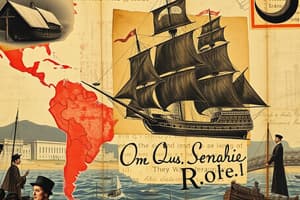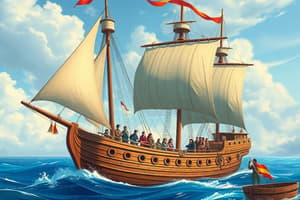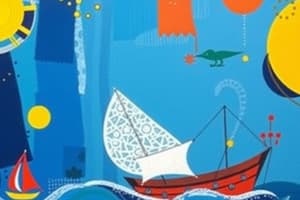Podcast
Questions and Answers
What was established in 1542 as a counterpart to the viceroyalty of New Spain?
What was established in 1542 as a counterpart to the viceroyalty of New Spain?
- Viceroyalty of Chile
- Viceroyalty of Argentina
- Viceroyalty of Peru (correct)
- Viceroyalty of Brazil
Which explorer began a series of explorations along the northern frontier of New Spain in the late 1530s?
Which explorer began a series of explorations along the northern frontier of New Spain in the late 1530s?
- Vasco Núñez de Balboa
- Juan Ponce de León
- Francisco Pizarro
- Hernando de Soto (correct)
Which native civilizations continued to resist Spanish control well into the 1570s?
Which native civilizations continued to resist Spanish control well into the 1570s?
- Mayas
- Incas (correct)
- Aztecs
- Tainos
What were some of the mound-building cultures' notable towns mentioned in the context of De Soto's explorations?
What were some of the mound-building cultures' notable towns mentioned in the context of De Soto's explorations?
Why did the Spanish not make determined efforts to colonize regions explored by De Soto for many years?
Why did the Spanish not make determined efforts to colonize regions explored by De Soto for many years?
What significant realization did Columbus come to during his third voyage?
What significant realization did Columbus come to during his third voyage?
What was the primary outcome of the Treaty of Tordesillas signed in 1494?
What was the primary outcome of the Treaty of Tordesillas signed in 1494?
Which conquistador was responsible for the downfall of the Aztec Empire?
Which conquistador was responsible for the downfall of the Aztec Empire?
What role did diseases like smallpox play in the Spanish conquest of the Americas?
What role did diseases like smallpox play in the Spanish conquest of the Americas?
Which civilization was in power in the Andes Mountains at the time of Spanish arrival?
Which civilization was in power in the Andes Mountains at the time of Spanish arrival?
Flashcards are hidden until you start studying
Study Notes
Columbus's Voyages
- Columbus made landfall on October 12, 1492, on an island he named San Salvador, believing he reached the East Indies.
- He referred to the native inhabitants as "Indians" and explored the Bahamas, northern Cuba, and Hispaniola before returning to Spain in January 1493.
- Isabella and Ferdinand of Spain commissioned Columbus for a second voyage with 17 ships, expanding his exploration throughout the Caribbean.
- On his third voyage (1498-1500), Columbus made first contact with the South American mainland.
- Columbus sailed along Central America's coastline during his fourth voyage (1502-1506) before his death in 1506.
Treaty of Tordesillas
- The Treaty of Tordesillas was signed on June 7, 1494, dividing the non-European world into Spanish and Portuguese spheres of influence.
- This treaty initially granted most of the Americas to Spain, although Brazil would later be recognized as Portuguese territory.
- Spanish settlements began with the establishment of Santo Domingo in 1496 by Bartholomew Columbus on Hispaniola.
Expansion of the Spanish Empire
- By 1515, Cuba became a central hub of Spanish power following its conquest and the establishment of Havana.
- Vasco Núñez de Balboa crossed the Isthmus of Panama in 1513, becoming the first European to see the Pacific Ocean.
- Advanced Native American civilizations like the Maya, Olmec, and Aztec were present in conquered territories.
Hernán Cortés and the Aztecs
- Cortés landed on the Mexican coastline in late 1518, establishing a base at Villa Rica de la Cruz.
- He allied with the Tlaxcalans, who opposed the Aztecs, and reached Tenochtitlan, where he captured Emperor Montezuma II.
- Cortés was later driven from Tenochtitlan during "La Noche Triste" in 1520 following Montezuma's death, but regrouped for a successful siege in 1521, leading to the fall of the Aztec Empire.
The Inca Empire and Pizarro
- The Inca Empire, dominant in present-day Peru, Ecuador, and Bolivia, was contacted in the mid-1520s by Spanish conquistadors Francisco Pizarro and Diego Almagro.
- Following Pizarro's return in 1531, a protracted conflict ensued against the Incas, leading to Pizarro's eventual control over the region and the establishment of Lima in 1542.
Spanish Colonial Society
- Spanish expansion was gradual, primarily focusing on Mexico and Peru.
- Mixed-race populations called mestizos emerged due to intermarriage between Spanish men and native women.
- The slave trade increased, especially in the Caribbean, to support labor-intensive sugar plantations.
Decline of the Spanish Empire
- By the late 17th century, Spain faced economic decline due to diminishing precious metal supplies and excessive spending on European wars.
- Rival nations, including the French, Dutch, and English, began establishing claims in previously neglected Spanish territories in North America and the Caribbean.
- Revolutions throughout Latin America in the early 19th century led to the loss of most Spanish territories, with Simon Bolivar playing a key role in liberating several regions.
Final Years of Spanish Rule
- The Cuban War of Independence began in 1895, culminating in the Spanish-American War of 1898.
- Following defeat in the war, Spain relinquished control of Cuba, Puerto Rico, and the Philippines to the United States.
- The once-mighty Spanish Empire, established with Columbus's voyages, came to an end after 400 years of colonial rule.
Studying That Suits You
Use AI to generate personalized quizzes and flashcards to suit your learning preferences.




